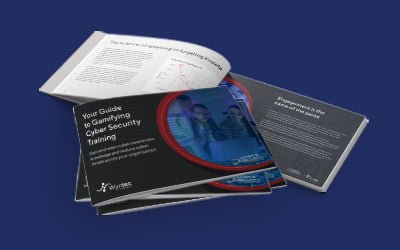In FY2022, the Australian Cyber Security Centre (ACSC) received 447 reports of ransomware incidents, an increase since FY2020 that impacted all sectors of our economy and is likely much higher for incidents that are not reported. Ransomware-as-a-Service is one emerging trend that has contributed to increasing reports. These services make it easier for an aspiring threat actor to access the tools, knowledge, and support to execute attacks.
When we say that cyber attacks like ransomware have become a growing concern, it is not only because of the increased numbers but that we have proof of cyber criminals updating their methods and making them more accessible.
Addressing these changes in the threat landscape necessitates a shift from traditional security measures to more advanced tools and strategies. The right approach can strengthen your organisation’s defences and equip you to prevent and mitigate the impact of ransomware attacks.
Elevating email security
Threat actors often use emails as the initial gateway for ransomware attacks, with threat actors deploying sophisticated phishing techniques to achieve Business Email Compromise (BEC) or trick someone into clicking a link. 45% of ransomware attacks this year started with a phishing email.
Traditional detection methods have difficulty keeping up with these threats. To counteract email-based attacks, your organisation needs advanced tools capable of identifying and filtering malicious emails, attachments, and links. These solutions use machine learning to analyse patterns and behaviours, effectively detecting phishing attempts, malware, and potential data leaks before they can successfully infiltrate your business.
Prioritising email security significantly reduces the risk of successful ransomware attacks. Advanced tools filter out potentially malicious content or provide users with context to analyse suspicious emails.
Strengthening endpoint security
Endpoints include any devices that access your business networks or systems, including desktops, laptops, mobile phones or tablets.
As more people work in hybrid environments, endpoint security has become a bigger necessity. Employees access networks from various locations, whether in the office, at home or on the go, and organisations require solutions that extend beyond the network perimeter and the four walls of the business.
Traditional endpoint security used to include antivirus software, but now it has evolved to include comprehensive protection against malware and zero-day attacks. Proactive endpoint management, including regular updates and monitoring, is crucial to prevent ransomware attacks. Advanced cyber security tools offer features such as event log monitoring, breach detection, threat hunting, and next-gen antivirus integrations to secure endpoints.
Adopting zero trust and identity access management
Zero trust is a security model that operates on a ‘never trust, always verify’ principle that authenticates and validates all users before giving them access to organisational resources. This approach can prevent ransomware attacks by checking credentials and confirming the legitimacy of every login attempt.
Identity access management takes zero trust a step further by using the principle of least privilege to restrict access to data and systems. In this instance, even if a threat actor compromises an account, their movements within the organisation become constrained by the access levels assigned to that account, mitigating potential damage.
Employee training can prevent ransomware
While technology solutions bolster your organisation’s cyber security posture, your team are the first line of defence against ransomware attacks. As many attacks originate from phishing attempts or social engineering, your team needs the skills to recognise and report suspicious behaviour.
Advanced tools can simulate ransomware attacks for training purposes. Simulated phishing attacks, for example, can be used to train employees on appropriate responses to threats.
A well-rounded cyber security training program equips employees with the skills to identify and avoid potential threats. By incorporating interactive modules, in-the-moment interventions, and personalised training plans, your organisation can increase the team’s awareness and knowledge retention so they act quickly when noticing suspicious behaviour.
Crafting and testing a proactive incident response plan
An incident response plan outlines the procedures your team enacts during a cyber security incident. The plan is not just about how your business will respond after a threat actor deploys ransomware. It focuses on the steps taken after proactively identifying a threat that has not yet deployed ransomware. The goal is to mitigate damage by preventing lateral movements within the organisation.
A proactive incident response plan is crucial for quickly recognising and neutralising threats. The plan monitors for malicious activities, identifies unauthorised services, and promptly responds to threat actors across endpoints, networks, and the cloud for precise and timely risk management. These factors are key, as 77% of businesses identified and reported malicious or criminal attacks to the Office of the Australian Information Commissioner (OAIC) within 30 days.
In addition to implementing monitoring and incident response, your organisation also needs a strategy for testing and adjusting the plan as needed. This practice heightens the understanding of roles and the steps taken across the organisation after identifying a threat, which helps you carry out the plan quickly.
Conclusion
Your organisation can deploy multiple tactics to strengthen defences against ransomware attacks. Advanced solutions that boost email security and endpoint protection prevent threat actors from accessing accounts and devices, regardless of whether your team works remotely or in the office. Zero trust and access management can take this further by verifying users and preventing people from accessing systems and data unnecessarily.
In the event that a threat actor infiltrates your business, an incident response plan defines the steps to remove the threat before it worsens. Your organisation should revisit this plan consistently to ensure it remains valid.
Wyntec can reduce the impact of ransomware attacks on your business
Our EndPoint Detection & Response (EDR) solution provides 24/7 surveillance of your IT infrastructure to quickly identify and neutralise threats. Our ThreatOps team provides advanced EDR technology and expertise to deliver robust defence mechanisms that ensure smooth and secure business operations. Visit our EndPoint Detection & Response page for more information on how we deliver stress-free IT.
Related blogs
5 ways a Vendor Assurance Program secures your business partnerships
Email Security Threats in 2023: What you need to know to protect your business
The art of hacking the hackers: A guide to defending online security





